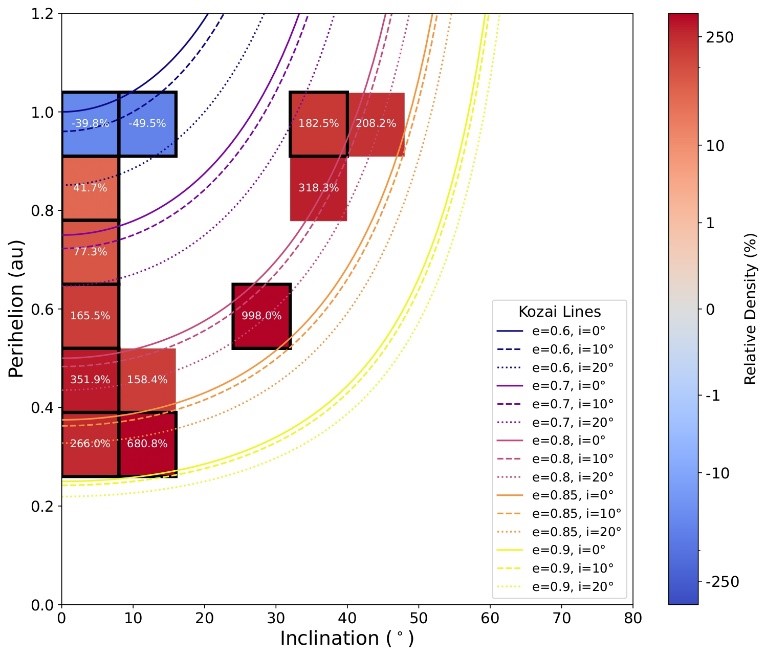Meteorites, witnesses to the Solar System’s past
A veritable celestial archive, meteorites are fragments of asteroids that enable us to trace the origins of the Solar System. Among them, carbonaceous chondrites occupy a special place. Originating from carbon-rich asteroids - such as Ryugu and Bennu, recently explored by the Hayabusa2 and OSIRIS-REx missions - these meteorites hold precious clues to the origin of water on Earth and the processes behind the first building blocks of life.
According to current models, a large majority of meteoroids - those objects before they enter the atmosphere - should be carbonaceous in nature. Indeed, most of them come from the asteroid belt, a region renowned for hosting carbon-rich bodies. It would therefore be logical to find a significant proportion of carbonaceous chondrites among the meteorites that have fallen to Earth.
| Yet the study reveals that only around 4% of recovered meteorites are carbonaceous chondrites - a striking departure from traditional models.. |
When the Sun and Earth’s atmosphere act as a double filter
To resolve this paradox, the team of international researchers led by Patrick Shober, a researcher at LTE (Laboratoire Temps Espace) at Paris Observatory - PSL, analyzed almost 8,000 meteorite impacts and 500 potential meteorite falls, using data collected by 19 global networks of photographic surveillance cameras. These specialized systems record the trajectory of small rocky bodies as they enter the atmosphere.
Their work shows that primitive meteorites undergo a dual process of natural selection :
|
New insights into the dynamics of small Solar System bodies}
These results not only explain a rarity observed on Earth : they also open up new perspectives on the evolution of primitive Solar System materials and their role in planet formation.
By refining our understanding of the mechanisms that alter these bodies, notably the thermal cycle caused by their close passage to the Sun and space weathering, this study enables us to better interpret the samples brought back by space missions. It also sheds light on how similar processes might influence the population and composition of small bodies in other planetary and exoplanetary systems, providing us with a valuable frame of reference for interpreting remote observations.
This publication illustrates the place of Paris Observatory in contemporary astrophysics, as its President, Fabienne Casoli, points out :
“By studying meteorites and small bodies in the solar system, astronomers seek to better understand the history of the Earth and planets, as well as that of extrasolar planets. Observatoire de Paris - PSL continues to assert its leading role in these research themes, drawing on theory, numerical simulations and structuring programs such as FRIPON, SPHERE+, MICADO, PLATO, JUICE, MMX-MIRS and ENVISION.”
About Observatoire de Paris - PSL
Founded in 1667, the Observatoire de Paris - PSL has been a center of innovation and discovery in astronomy for nearly 360 years. With 750 researchers and teacher-researchers, engineers, technicians and administrative staff, the establishment conducts research on its 3 campuses - Paris, Meudon and Nançay - in astrophysics, physics, engineering and the metrology of time and space. Its work combines theory, numerics, experimentation, ground-based and space-based observations, and instrumental development. Observatoire de Paris - PSL is responsible for the production of French legal time and ephemerides for the Sun, Moon and solar system bodies, which are entrusted to it by decree. It operates state-of-the-art radio telescopes at its Nançay site. It offers academic training (Masters, PhD), training for the general public and teachers, and class sponsorship. It is a founding member of the Université Paris Sciences et Lettres, where it runs the Astrophysics graduate program.

| Winner of the Paris Region fellowship program supported by the Île-de-France Region This project has received funding under the "Horizon 2020" framework program for research and innovation as part of Marie Sklodowska-Curie grant agreement no. 945298. |
Collaboration
– Patrick M. Shober - LTE, Observatoire de Paris-PSL, Sorbonne Université, Université de Lille, LNE, CNRS
– Hadrien A.R. Devillepoix - Space Science and Technology Centre, Curtin University ; International Centre for Radio Astronomy Research, Curtin University
– Jérémie Vaubaillon - LTE, Observatoire de Paris-PSL, Sorbonne University, Université de Lille, LNE, CNRS
– Simon Anghel - LTE, Observatoire de Paris-PSL, Sorbonne Université, Université de Lille, LNE, CNRS ; Astronomical Institute of the Romanian Academy
– Sophie E. Deam - Space Science and Technology Centre, Curtin University ; International Centre for Radio Astronomy Research, Curtin University
– Eleanor K. Sansom - International Centre for Radio Astronomy Research, Curtin University ; Space Science and Technology Centre, Curtin University
– François Colas - LTE, Observatoire de Paris-PSL, Sorbonne Université, Université de Lille, LNE, CNRS
– Brigitte Zanda - Institut de Minéralogie, Physique des Matériaux et Cosmochimie, Muséum National d’Histoire Naturelle, CNRS ; LTE, Observatoire de Paris-PSL, Sorbonne Université, Université de Lille, LNE, CNRS
– Pierre Vernazza - Laboratoire d’Astrophysique de Marseille, Aix-Marseille Université, CNRS, CNES, LAM, Institut Origines
– Phil Bland - Space Science and Technology Centre, Curtin University
